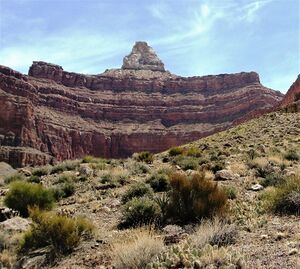Earth:Zoroaster Temple
| Zoroaster Temple | |
|---|---|
 Southwest aspect | |
| Highest point | |
| Elevation | 7,123 ft (2,171 m) [1] |
| Prominence | 763 ft (233 m) [1] |
| Parent peak | Brahma Temple (7,551 ft)[2] |
| Isolation | 0.88 mi (1.42 km) [2] |
| Coordinates | [ ⚑ ] : 36°07′08″N 112°02′43″W / 36.1188141°N 112.0452408°W [3] |
| Geography | |
Lua error in Module:Location_map at line 522: Unable to find the specified location map definition: "Module:Location map/data/Arizona" does not exist.
| |
| Location | Grand Canyon Coconino County, Arizona, US |
| Parent range | Kaibab Plateau[1] Colorado Plateau |
| Topo map | USGS Phantom Ranch |
| Geology | |
| Type of rock | Coconino Sandstone |
| Climbing | |
| First ascent | 1958 |
| Easiest route | class 5.7 climbing[2] |
Zoroaster Temple is a 7,123-foot-elevation (2,171-meter) summit located in the Grand Canyon, in Coconino County of Arizona, USA.[3] It is situated 5.5 miles (8.9 km) northeast of the Yavapai Point overlook on the canyon's South Rim, from which it can be seen towering over 4,600 feet (1,400 meters) above the Colorado River and Granite Gorge. Its nearest higher neighbor is Brahma Temple, less than one mile to the north-northeast.[1] Zoroaster Temple is named for Zoroaster, an ancient Iranian prophet. This name was used by George Wharton James and Clarence Dutton.[4] Dutton began the tradition of naming geographical features in the Grand Canyon after mythological deities.[5] This geographical feature's name was officially adopted in 1906 by the U.S. Board on Geographic Names.[3]
The first ascent of the summit was made by Rick Tidrick and Dave Ganci in September 1958 via the NE Arete (class 5.9+).[6][7] Other climbing routes include Screaming Sky Crack (class 5.11a FA 1994), and SE Face, a challenging class 5.11+ route that was first climbed in 2012. The 1958 Zoroaster ascent was the first technical climb in the Grand Canyon, transforming the Grand Canyon into a climbing mecca and setting off a rush to climb the many summits. According to the Köppen climate classification system, Zoroaster Temple is located in a Cold semi-arid climate zone.[8]
Geology
The summit spire of Zoroaster Temple is composed of cream-colored, cliff-forming, Permian Coconino Sandstone with a small, remnant Kaibab Limestone and Toroweap Formation caprock.[9] The sandstone, which is the third-youngest of the strata in the Grand Canyon, was deposited 265 million years ago as sand dunes. Below the Coconino Sandstone is slope-forming, Permian Hermit Formation, which in turn overlays the Pennsylvanian-Permian Supai Group. Further down are strata of Mississippian Redwall Limestone, Cambrian Tonto Group, and finally granite of the Paleoproterozoic Vishnu Basement Rocks at river level.[10] Precipitation runoff from this feature drains south into the Colorado River via Zoroaster and Bright Angel Canyons.
Tonto Group & Vishnu Basement Rocks
The 3-unit Tonto Group rests on the Tonto Platform and is part of the Great Unconformity, expressed in many parts of the Grand Canyon. (The horizontal platform is the location of the Tonto Trail, extensive on the south side of Granite Gorge.)
The 3-unit Tonto Group has the lowest/base unit of highly resistant cliff-forming, typically short height Tapeats Sandstone. It is the contact layer with the Vishnu Basement Rocks below.
The majority thickness of the Tonto Group, is the slope-forming and commonly colorful dull-greenish Bright Angel Shale. The Shale slopes are below the 3rd unit, which sits as a short, resistant cliff at the base of the massive cliffs of the Redwall Limestone, the Muav Limestone.
Sumner Butte
Sumner Butte is a notable 5,126-foot-elevation geographical feature at the end of Zoroaster Temple's long west arm.[11] With a prominence of only 106 feet it does not meet the criteria of a stand-alone summit, but does have a striking southwest face as it towers over 2,500 feet above Phantom Ranch at the confluence of the Colorado River and Bright Angel Creek.[12] It is named for Jack Sumner (1840–1907), head boatman for John Wesley Powell's 1869 expedition down the Colorado River through the Grand Canyon.[13]
Gallery
See also
- Geology of the Grand Canyon area
References
- ↑ 1.0 1.1 1.2 1.3 "Zoroaster Temple, Arizona". http://www.peakbagger.com/peak.aspx?pid=86547.
- ↑ 2.0 2.1 2.2 "Zoroaster Temple – 7,123' AZ". https://listsofjohn.com/peak/72048.
- ↑ 3.0 3.1 3.2 "Zoroaster Temple". United States Geological Survey. https://geonames.usgs.gov/apex/f?p=gnispq:3:::NO::P3_FID:14141.
- ↑ Susan and Phil Frank, The Grand Canyon Handbook, An Insider's Guide to the Park, 2000, Pomegranate Communications Inc., page 204.
- ↑ Randy Moore and Kara Felicia Witt, The Grand Canyon: An Encyclopedia of Geography, History, and Culture, 2018, ABC-CLIO Publisher, page 151.
- ↑ Todd R. Berger, Reflections of Grand Canyon Historians: Ideas, Arguments and First-Person Accounts, 2nd edition, 2008, Grand Canyon Association Publisher, ISBN:978-1934656006, page 195.
- ↑ Kathleen Bryant, Moon Grand Canyon, 2017, Avalon Publishing
- ↑ Peel, M. C.; Finlayson, B. L.; McMahon, T. A. (2007). "Updated world map of the Köppen−Geiger climate classification". Hydrol. Earth Syst. Sci. 11. ISSN 1027-5606.
- ↑ William Kenneth Hamblin, Anatomy of the Grand Canyon: Panoramas of the Canyon's Geology, 2008, Grand Canyon Association Publisher, ISBN:9781934656013.
- ↑ N.H. Darton, Story of the Grand Canyon of Arizona, 1917, pages 32, 48.
- ↑ "Sumner Butte". United States Geological Survey. https://geonames.usgs.gov/apex/f?p=gnispq:3:::NO::P3_FID:42731.
- ↑ "Sumner Butte – 5,126' AZ". https://listsofjohn.com/peak/75340.
- ↑ Gregory McNamee, Grand Canyon Place Names, 1997, Johnson Books.
External links
- Weather forecast: National Weather Service
- Zoroaster Temple rock climbing: Mountainproject.com
- Zoroaster pronunciation
 |














